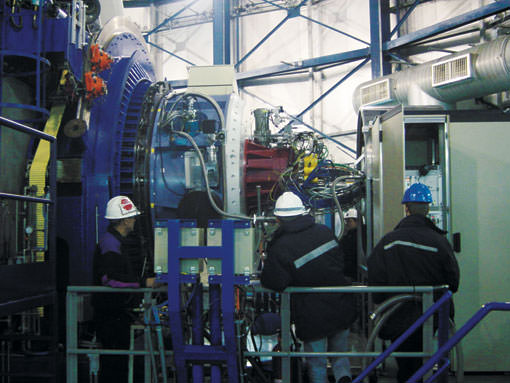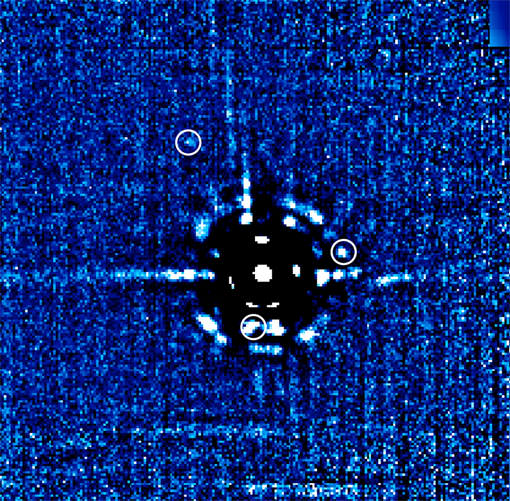[/caption]
Astronomers have obtained the first direct spectrum – a “chemical fingerprint” – of a planet orbiting a distant, Sun-like star, providing direct data about the composition of the planet’s atmosphere. An international team of researchers studied the planetary system around HR 8799 a bright, young star with 1.5 times the mass of our Sun, and focused on one of three planets orbiting the star. While the results were unusual and pose a challenge to current models of the exoplanet’s atmosphere, the accomplishment represents a milestone in the search for life elsewhere in the Universe.
The planetary system resembles a scaled-up version of our own Solar System and includes three giant planets, which had been detected in 2008 in another study. “Our target was the middle planet of the three,” said team member and PhD student Carolina Bergfors, from the Max Planck Institute for Astronomy, (MPIA), “which is roughly ten times more massive than Jupiter and has a temperature of about 800 degrees Celsius,”

Caption: The NaCo instrument, mounted at ESO’s Very Large Telescope on Paranal in Chile. NaCo is a combination of adaptive optics (which counteracts some of the blurring effect of the Earth’s atmosphere) and the camera/spectrograph CONICA, which was developed at the Max Planck Institute for Astronomy and the Max Planck Institute for Extraterrestrial Physics. Image credit: ESO
The researchers recorded the spectrum using the NACO instrument ion the Very Large Telescope (VLT) in Chile.
As the host star is several thousand times brighter than the planet, and the two are very close, obtaining such a spectrum is an immense feat.
“It’s like trying to see what a candle is made of, by observing it next to a blinding 300 Watt lamp – from a distance of 2 kilometres [1.3 miles],” said Markus Janson of the University of Toronto, lead author of the paper.
Bergfors added, “It took more than five hours of exposure time, but we were able to tease out the planet’s spectrum from the host star’s much brighter light.”
However, the spectra of the exoplanet’s atmosphere shows a clear deviation between the observed spectral shape and what is predicted by the current standard models. “The features observed in the spectrum are not compatible with current theoretical models,” said MPIA’s Wolfgang Brandner, a co-author of the study.
The models assume chemical equilibrium between the different chemical elements present in the atmosphere, and a continuous temperature profile (hotter layers below colder layers). At longer wavelengths (above 4 micrometres), the planet is significantly fainter than expected, which points to molecular absorption spectrum in its atmosphere. The simplest explanation is that the atmosphere contains less methane and more carbon monoxide than previously assumed.
“We need to take into account a more detailed description of the atmospheric dust clouds, or accept that the atmosphere has a different chemical composition than previously assumed,” Brandner said.
In time, the astronomers hope that this technique will help them gain a better understanding of how planets form. Next, they hope to record the spectra of the two other giant planets orbiting HR 8799 – which would represent the first time that astronomers would be able to compare the spectra of three exoplanets that form part of one and the same system. As a much more distant goal, the technique will allow astronomers to examine exoplanets for habitability, or even signs of life.


This is unbelievable! first the image of betelgeuse few weeks ago. Now much sharper image with two distinct spots and direct spectral observation of exoplanet that is thousands of times smaller than betelgeuse. 20 years ago we haven’t even knew about a single exoplanet. Where will we be in next 20?
This is absolutely outstanding!
I wonder if it will really be worth recalculating the models for the eclipse method, when this looks at the planet directly. Until there are enough samples from this new method for an accuracy comparison, I think there will always be a question with it.
I am really interested in out how similar exoplanets are to their neighbors, especially the composition of gas planets, and the thought of watching planets form is probably blowing just about everyones mind.
Wow – nice work. It surely will not be long before such observations become commonplace. And once spectrographic observations of exoplanets become the norm… It doesn’t take a genius to figure out that we are on the verge of the next great breakthrough in our understanding of our place in the universe.
I agree renoor – where will we be in 20 years? The mind tends towards backflips just thinking about it. With the amount of hardware that’ll be coming online in the next 20 years, and then the next 20 and then the next 20, I often find myself almost wishing my life away just to see what the next mission or telescope will discover. Happy days!
I have been actively involved in amateur astronomy for many years and the type of imaging being done now would have been unthinkable when I first started teaching it. Of course, that was a few years ago now, before the HST, etc. The old images from the 200″ reflector were about the best we had. Now you can get better using digital imaging from a medium sized Celestron! Measuring the spectrum of an extra-solar planet though? That really is awesome!